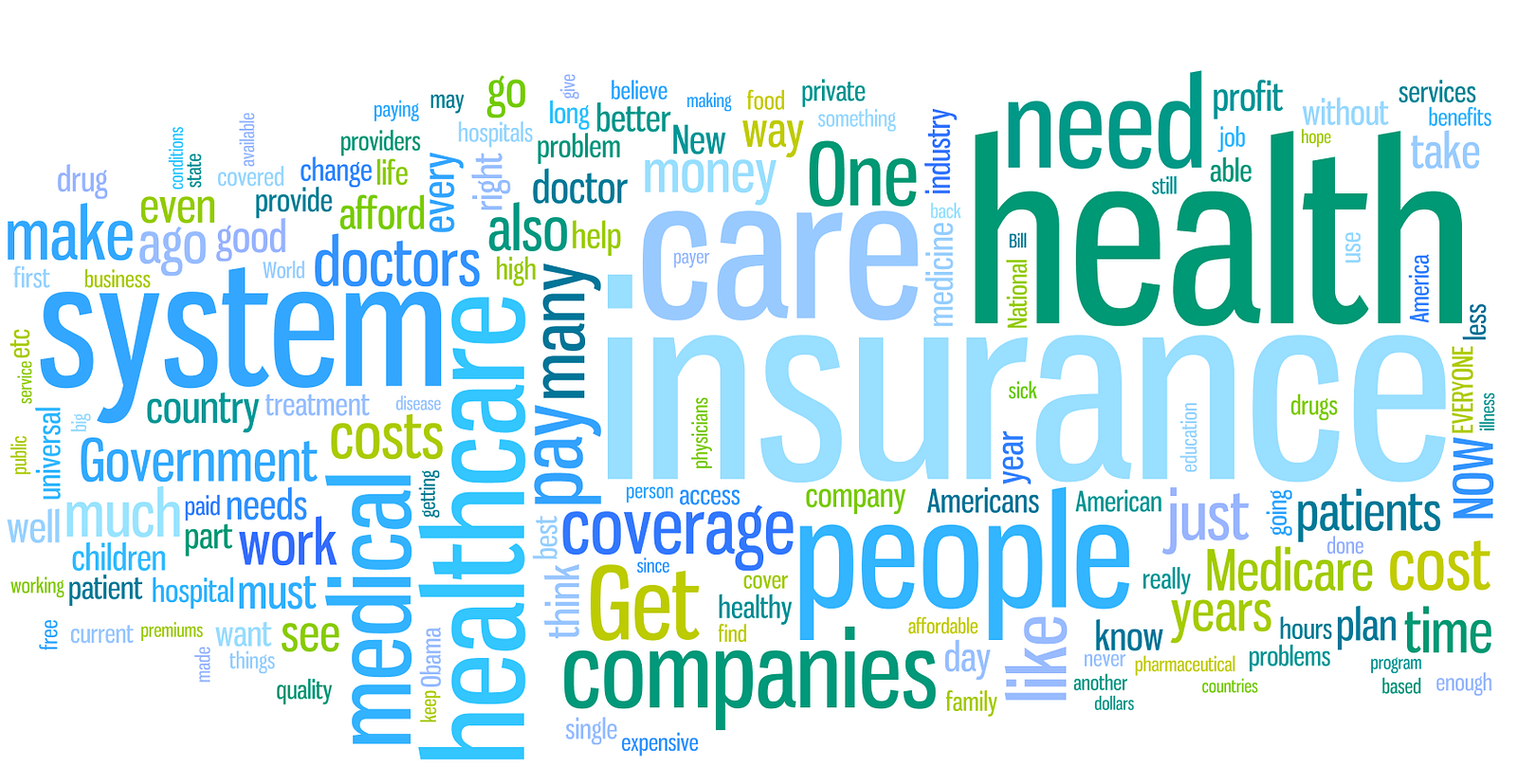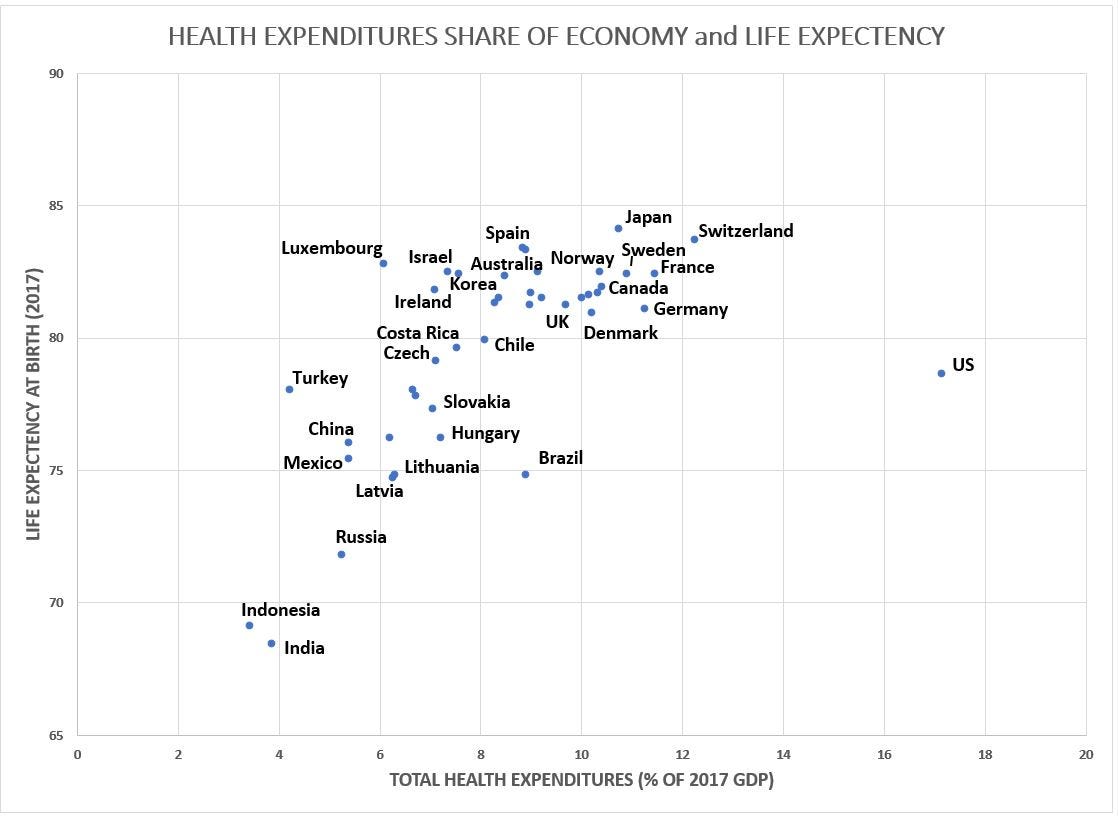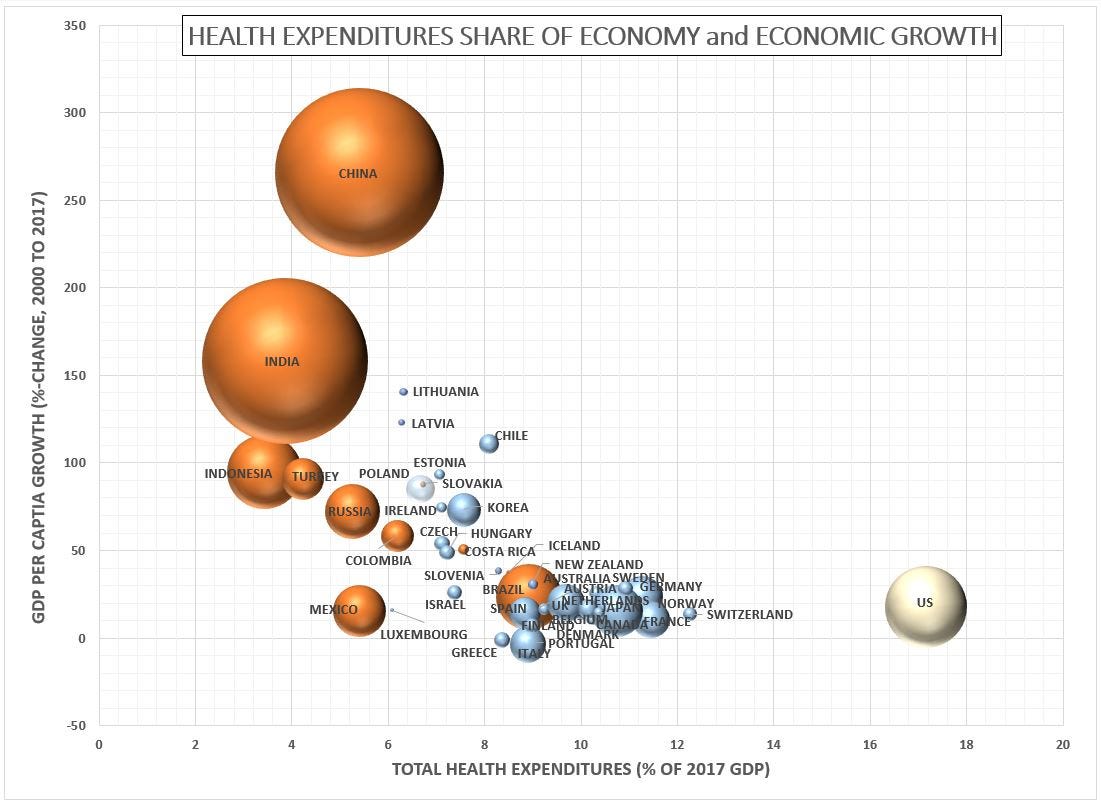Why can European countries afford universal health care and the U.S. can’t?
Why can European countries afford universal health care and the U.S. can’t?
By Kent R. Kroeger (September 26, 2018)


“It has been the goal of Democrats since Franklin D. Roosevelt to create a universal health care system guaranteeing health care to all people,” starts Vermont Senator Bernie Sanders’ stump speech as he promotes his Medicare-4-All (M4A) legislation. “Every other major industrialized nation has done so.”
He is correct. All major industrialized nations have either a straight single-payer system (Korea, Canada), a Beveridge Model single-payer system (UK, Sweden, Norway) or other type of universal coverage system (Germany, Australia, Spain). The U.S. stands along among industrialized countries in how it addresses health care.
But Sanders is wrong to suggest all Democrats share the goal of universal health care. In reality, the party has been, and remains, deeply divided on this issue. If the party were as united as Sanders suggests, they would have passed a single-payer system in 2008 instead of Obamacare which passed without any Republican support.
Why didn’t the Democrats pass a single-payer system? Because vested interests in the current private, employer-based health care system — physicians, pharmaceutical companies, and insurance companies — are too powerful within the Democratic Party to allow passage of a single-payer system that would dramatically reduce doctors’ incomes, virtually eliminate the private health insurance industry, and force U.S. pharmaceutical companies to face real price competition.
Americans pay more and get less
Any conversation about the U.S. health care system must start with this indisputable fact: Americans pay more and get less when compared to citizens in other industrialized countries.
According to the Organisation for Economic Co-operation and Development (OECD), health care expenditures account over 17 percent of the U.S. economy, compared to 10.1 percent for West European countries (see Figure 1).
Figure 1. Health Expenditures as a Percent of 2017 GDP
And the Republican retort goes something like this. Yes, we spend more, but we have the best doctors, hospitals and medical technology in the world. That comes with a price, well worth paying, say the Republicans.
However, the Republicans are faced with this inconvenient fact. Americans pay more for health care and, yet, on most health outcome measures under-perform compared to other industrialized countries.
As a share of the total economy, the U.S. spends almost twice as much on health care as Spain, South Korea, Australia, Norway, UK, Ireland, and Israel, but its citizens have a life expectancy five years lower than those countries (see Figure 2). Americans live as long as Turks (78.6 and 78.0 years, respectively). But Turkey devotes only 4 percent of their economy to health expenditures.
Figure 2. Health Expenditures Share of Economy and Life Expectancy


Another health outcome measure developed by the OECD is Potential Years of Life Lost. This metric summarizes premature mortality, such that, in countries where death rates for younger citizens are higher than a benchmark average, the assumption can reasonably be drawn that many of those deaths were preventable. Figure 3 plots national health expenditures by potential years of life lost. Again, the U.S. spends more on health care but experiences levels of preventable deaths on par with Colombia, Turkey and Costa Rica. America is not a health care system success story. The other stark finding from this metric is that too many Russians are dying at a far too young age (alcoholism).
Figure 3. Health Expenditures Share of Economy and Potential Years of Life Lost


The following statement my seem overly harsh, particularly if you have a doctor in the family, but there is only one conclusion that can be drawn from the health care outcome data: American doctors and hospitals deliver inferior care relative to their cost.
But establishment Democrats and Republicans continue to defend this sub-optimal health care delivery system and often fall back on the biggest canard of all: Single-payer systems expand the welfare state and crush economic growth and opportunity.
While it is an argument with a large, willing audience in the U.S., it is brutally inaccurate (see Figure 4). Don’t let the U.S.’s current economic growth cloud your understanding of the longer-term trends. Yes, the U.S. has a strong economy, but our GDP per capital growth rate between 2000 and 2017 was comparable to Canada’s (17.9 and 17.2 percent, respectively), and behind UK (19.9) and Germany (23.3 percent).
Figure 4. Health Expenditures Share of Economy and Economic Growth


But those countries with socialist health care systems are saddled with over-whelming debt, is the Republicans last plea for reason.
Well…again…No.
According to the International Monetary Fund, in terms of total gross government debt as a percent of GDP, the U.S. has one of the highest debt-to-GDP ratios in the world (108), exceeded only by Europe’s economic basket cases like Greece (182), Italy (131) and Portugal (126). France’s ratio is 97 percent and Canada’s is 90 percent — not great, but debt levels both countries are capable of handling. The UK, with its single-payer National Health Service, has a debt-to-GDP ratio of 87 percent; and Germany carries one of the lowest debt ratios among the large, industrialized economies at 64 percent.
The poster child for socialized medicine — the U.K.’s National Health Service — is still routinely rated as one of the best in the world (see here, here, and here) and the country did not have to sink into a bottomless debt hole to build and maintain it.
So, all that background chatter against universal health care systems over socialism and debt and dying on surgery wait lists is mostly bunk. Its an easy sell, particularly to American voters, but the on basis of the data, socialized medicine works remarkably well within otherwise capitalist, free market economies.
So, why hasn’t the U.S. adopted a single-payer system?
In fairness, there are genuine problems the U.S. would face if it tried to mimic a single-payer system such those in Canada and the UK. The vested interests enriched by the U.S. health care system are large and powerful — pharmaceutical companies, physicians, medical equipment manufacturers, insurance companies — and would all be adversely affected by the implementation of any form of universal health care, be it a single-payer system or a public-private hybrid (such as in Germany).
Dr. Deane Waldman, in an op-ed piece for TheHill.com, does an excellent job of laying out the standard argument against Medicare-4-All (and other single-payer concepts):
“ Let’s start with costs. The best estimate we have now is from Charles Blahous of Mercatus Center at George Mason University. He puts the price tag of single-payer healthcare at $32.6 trillion over ten years… This would double what we spend annually on healthcare, more than $3.3 trillion in 2017.
To achieve the cost of “only” $32.6 trillion, Blahous calculated that the federal government would have to cut doctor reimbursements to 40 percent of private insurance payments, which are already negotiated down below usual and customary prices.
It’s all about rationing. In single-payer systems, the government saves money not by more efficient administration, but by controlling both the budget and by limiting allowable treatments. In other words, they ration care by restricting allocations to facilities (resulting in too few operating rooms or burn units), reducing payment schedules (resulting in fewer physicians available to treat patients), and delaying or denying treatments that are very expensive.”
Cost, rationing, and price/salary controls. Those are typically cited as the barriers to a U.S. universal health care system.
But what if?
But what if Bernie Sanders is elected president in 2020 and the Democrats hold majorities in both congressional chambers? What if, theoretically, he has the votes and the public support to implement M4A? What would stop him?
To change the American health care system, we need to understand what makes health care delivery so expensive; and, unfortunately, any system as complex as health care cannot be summarized by only three or four cost factors. Nonetheless, here are the most likely culprits:
- High administrative costs (health insurance companies).
- U.S. physician incomes much higher than in other industrialized countries.
- U.S. pharmaceutical companies not subjected to sufficient price competition.
- Higher medical equipment costs.
- Unnecessary care or care largely unrelated to life expectancy (Viagra).
- Too much health care delivered to Americans through emergency room care.
- We talk about the cost-effectiveness of preventative care, but I see too many cars parked at The Golden Corral and Olive Garden each weekend to believe Americans have taken that message to heart, literally. Americans are overweight and the social penalty is that too much expensive specialist-delivered health care is required near the end of life to compensate for bad lifestyle decisions in our 40s and 50s.
If health care reform doesn’t address all of the cost factors in a comprehensive fashion, the cost of M4A (or any other universal health care system) will be too prohibitive.
Establishment politicians represent corporate interests
Along with the cost factors that make re-designing the U.S. health care system difficult, politicians and their misplaced priorities are the biggest barrier to substantive reform.
Money is central to American politics. It requires $1 million to run a credible U.S. House campaign. The average winning U.S. Senate campaign in 2016 raised $10.4 million. And to run for president? Hillary Clinton raised $1.2 billion just to lose. In total, American politicians raised $6.5 billion in 2016. That may seem like a big number, but keep it in perspective: Americans spent $5.24 billion on pet grooming last year.
It is not the money that drives incumbent politicians to vote predominately in the interests of their corporate donors. The money is a reflection of a deeper association between politicians and corporate interests. In general, national politicians, journalists, opinion leaders, academics, lobbyists, and business leaders go to the same colleges, live in the same neighborhoods, attend the same parties, use the same investment advisers and vacation on the same islands.
Of course, there are CEOs that graduated from places like The University of Nebraska (Warren Buffett) and Our Lady of the Lake University (Joe Gorder , CEO of Valero Energy). But when you view the complete list of universities attended by American CEOs, a small set of universities pop up consistently: Harvard, Stanford, Yale, Cornell, Columbia, Princeton, Univ. of Chicago, Dartmouth, Penn State, Notre Dame, Wisconsin, and the U.S. Military Academy.
The Top 10 list of universities attended by U.S. congressional members is similar: Harvard, Stanford, Yale, UCLA, Georgetown, Florida, Georgia, Wisconsin, North Carolina, Brigham Young (tie) and George Washington University (tie).
And journalism has its own diversity problem. The Atlantic’s Andrew McGill sounded the ‘elitist’ alarm in journalism right after Donald Trump’s 2016 election victory. “In 1960, nearly a third of reporters and editors had never attended a single year of college; in 2015, only 8.3 percent could say the same, according to Census figures extracted with the help of the University of Minnesota’s IPUMS project,” he wrote. “Media organizations have struggled for a long time with a habit of hiring identical people.”
The politician-corporate-media nexus is a socio-cultural clique that isolates itself from the broader public, as it mirrors the increasing concentration of wealth in the U.S. In terms of economic and social mobility, the U.S. has more in common with Pakistan than Germany or Canada.
Figure 5. Countries Ranked by the Strength of the Tie Between Father and Son Earnings (2012)
The concentration of wealth and power has had a demonstrable impact, not just on economic and social mobility, but on public policy.
In their 2014 landmark study of U.S. public policy and interest representation, political scientists Martin Gilens and Benjamin I. Page found that business interests dominate mass public interests in the formation of U.S. public policy for two reasons: (1) a physical proximity to power (Washington, D.C.), (2) and issue stance cohesion.
“The advantage of business-oriented groups in shaping policy outcomes reflects their numerical advantage within the interest-group universe in Washington, and also the infrequency with which business groups are found simultaneously on both sides of a proposed policy change,” concluded Gilens and Page. “When the preferences of economic elites and the stands of organized interest groups are controlled for, the preferences of the average American appear to have only a minuscule, near-zero, statistically non-significant impact upon public policy.”
Writing for The Atlantic in 2015, Lee Drutman documented how U.S. corporations since the 1960s have become much better at lobbying the government and how this has had a direct impact on the U.S. health care system. “As companies became more politically active and comfortable during the late 1980s and the 1990s, their lobbyists became more politically visionary. For example, pharmaceutical companies had long opposed the idea of government adding a prescription drug benefit to Medicare, on the theory that this would give government bargaining power through bulk purchasing, thereby reducing drug industry profits. But sometime around 2000, industry lobbyists dreamed up the bold idea of proposing and supporting what became Medicare Part D — a prescription drug benefit, but one which explicitly forbade bulk purchasing — an estimated $205 billion benefit to companies over a 10-year period.”
That’s real money and companies, as you would expect them to, are going to protect and enhance their economic interests any (legal) way they can, including financing the American political system.
Every election cycle, politicians and big money donors engage in an intricate mating dance where political donations are a focal, ritualized event, used by donors as much for virtue and status signaling as it is for affecting public policy, and used by politicians to signal their campaign’s viability to donors and political opponents.
So, how will we ever see health care reform in the U.S. when even the political party most likely to initiate such reform — the Democrats — is led by politicians far too cozy with pharmaceutical companies, the insurance industry, and physician lobbyists?
New Jersey Senator Cory Booker, a likely 2020 presidential candidate, has already taken in $482,79 from Pharmaceuticals/Health Products-related individuals and PACs during the 2018 election cycle, which isn’t quite as much as given by the Insurance industry ($513,580). Health Professionals have contributed$367,219 to go along with Hospitals/Nursing Homes-related individuals and PACs throwing in $240,780.
“Their money doesn’t buy my vote,” Booker frequently tells audiences when he’s challenged about his ties to big corporate donors. And I don’t disagree with him, because, like most politicians, he was probably already aligned with those corporate interests before he took one dime from them.
Another likely contender for the 2020 Democratic presidential nomination will be New York Senator Kirsten Gillibrand, once a favorite of the Clintons before her #MeToo betrayal of Bill Clinton, is no stranger to health industry campaign donations. In the current election cycle, she’s already pocketed $363,195 from Health Professionals-related individuals and PACs, $343,948 from the insurance industry, and $231,529 from pharmaceuticals.
What makes Britain special that they can deliver superior health care to their citizens, on average, while devoting a much smaller share of their total economy to health spending, compared to the U.S.?
First, the UK jumped on the single-payer system idea much earlier (1948) when vested interests against the idea were weaker and the structural costs of converting to a public health care system where relatively low. For the U.S. to do something similar requires dismantling the health insurance industry and other economic interests that have grafted themselves onto the current private-based health care system.
Second, it comes down to priorities. The U.S. can’t spend 50 percent of federal discretionary dollars on defense spending and also reform the health care system. How many U.S.-backed regime change wars have to fail before we realize there are better ways to spend our tax dollars? And you want free tuition at public universities too? Add to this policy inventory the future costs of climate change and an aging population and the prospect for substantive health care reform is rather dim.
An articulate, coherent leader will need to set well-defined priorities and be able to sell them to the public, corporate interests, and the political class. It will mean choosing to do some things and not others, which will alienate the constituencies who want to get those ‘other’ things done first. I don’t know if our political system is capable of this type of consensus-building anymore.
Yet, I continue to believe it is still possible for the U.S. to radically reform its under-performing health care system, but some sacred cows for certain will need to be slaughtered (not eaten, however).
- K.R.K.
